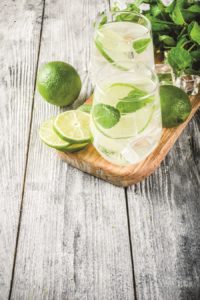Memorial Day, marking the unofficial start of summer, has come and gone this year in a way unlike any before: no crowds, no traffic, no large gatherings. Only the middling weather was not unusual. Putting aside the understandable emotions of this particular season, I see no reason why we shouldn’t mark the start of it by embracing a familiar cocktail. Having a “G&T” is quintessential summer. It is light, bright, and bubbly and can bring a refreshing smile to even the most wrung-out among us.
The traditional gin and tonic consists of but three ingredients (plus ice): gin, tonic water, and lime. The defining and slightly bitter tang in the drink comes from the quinine in the tonic water.
Quinine is a compound extracted from the bark of the cinchona tree commonly found in South America and parts of the Caribbean. As one of the first effective treatments against malaria, quinine quickly became essential in mosquito-infested parts of the world. The addition of gin surely made the quinine more palatable.
The drink was popularized by the British, who also invented London dry gin, the type of gin used in the “gin tonic,” as they say across the pond. You might say it enabled imperialism. Cue images of the Raj, a safari in Kenya, and the Panama Canal — all of which became possible once malaria was tamed by quinine.
Any London gin will make a decent cocktail. Brands such as Gordon’s, Beefeater, Tanqueray, and Bombay all work very well, as do tonic waters from Schwepps, Canada Dry, and, because it’s made in Massachusetts, Polar. A nice juicy lime is essential.
Elevate the experience by elevating the gin and the tonic water. Our house gin and tonic for the last several years is a good place to start (and to finish, for that matter). We use Hendrick’s gin, introduced only about 20 years ago, and Fever Tree tonic water. Unlike other dry gins, Hendrick’s has added flavors of rose and cucumber — flavors that are emblems of summer. The small bottles of Fever Tree are made with cane sugar rather than the high fructose corn syrup found in many mass-produced versions.
I like to take things a bit further, and I may lose some purists over this. Two additional ingredients that can take the G&T over the top: fresh mint and elderflower liqueur. I remember hearing years ago that using mint in a gin tonic was very popular on Nantucket, so why not the Outer Cape? Elderflower burst forth in the aughts and quickly became overused. But in this gin tonic, the stuff sings. In making your G&T, the usual ratio is one part gin to three parts tonic water. This works well, though in some places (such as Spain), the ratio is reversed. Feel free to mix it up a bit, as it were.

Over the Top G&T
for one cocktail
1.5 oz. London dry gin, or a bit more
4 oz. tonic water, or a bit less
About 1 tsp. elderflower liqueur
4-5 mint leaves
A wedge of lime
In a tall (aka highball) glass, muddle (gently mash with a wooden spoon or a muddler) four or five leaves of fresh mint with a healthy dash of elderflower liqueur and juice from a lime wedge.
The muddling combines the various flavors as it releases oils from the mint and skin of the lime.
Fill the glass with ice. Add the gin and tonic, using approximately one part gin to three parts good tonic water. Stir with a long spoon. Take a long sip. Smile.
Blues on the Side
If you want your cocktail with a snack that matches its summer spirit, just add bluefish.
Smearing bluefish paté on a cracker is a perfectly good option for the lazy. But if you’ve just invested in that fancy tonic water John Guerra suggests, why not go the extra mile? John slathers Mac’s bluefish pate on toasted rounds of PB Boulangerie’s bacon and cheese batard. Or I like this one: start with a few of those extra thick and crispy potato chips, add a dollop of thick sour cream, and lay a shard of locally smoked bluefish on top. Scatter minced chives over everything. —Teresa Parker



